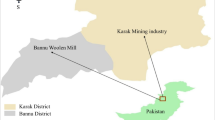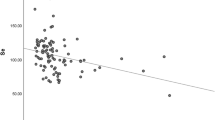Abstract
In spite of the established knowledge regarding their toxicities, occupational exposure to heavy metals like lead and cadmium still continues because of their wide distribution in environment. Due to lack of awareness, most of the workers usually eat, smoke, drink at their workplace which may aggravate the metal exposure. The present study was planned to assess the blood levels of lead and cadmium in occupationally exposed workers of Jodhpur (India). A total of 110 individuals working in different industrial set ups (furniture, metal handicraft, welders) of Jodhpur district (exposed group), aged between 20 and 60 years and 97 apparently healthy people (controls) with no history of occupational heavy metal exposure aged between 25 and 60 were recruited. Details of personal habits and demographics were recorded by means of self-developed questionnaire. 5 ml of whole blood was drawn from every individual. Metal levels were measured by graphite furnace atomic absorption spectrophotometer. Statistical analysis was done using GraphPad Prism Software. Results showed that Blood Lead Level and Blood Cadmium Level (CdB) were significantly higher in the exposed group as compared to the non-exposed group. Significant age and gender-based differences were found in terms of blood cadmium levels but no such difference was observed in case of blood lead. The study also revealed that higher blood levels of these metals in workers are influenced by their occupational practices, lack of protection against workplace environment pollutants, thus increasing their susceptibility to metal toxicity.

Similar content being viewed by others
References
Jan A, Azam M, Siddiqui K, Ali A, Choi I, Haq Q. Heavy metals and human health: mechanistic insight into toxicity and counter defense system of antioxidants. IJMS. 2015;16(12):29592–630.
Rushton L. The global burden of occupational disease. Curr Environ Health Rep. 2017;4(3):340–8.
Mitra P, Sharma S, Purohit P, Sharma P. Clinical and molecular aspects of lead toxicity: an update. Crit Rev Clin Lab Sci. 2017;54(7–8):506–28.
Assi MA, Hezmee MNM, Haron AW, Sabri MY, Rajion MA. The detrimental effects of lead on human and animal health. Vet World. 2016;9(6):660–71.
Ldh.la.gov. https://www.ldh.la.gov/assets/oph/Center-EH/envepi/occ_health/Documents/Cadmium_for_Health_Providers_Final_2017.pdf (2020).
ATSDR. 2015. Agency for Toxic Substances and Disease Registry (ATSDR). Toxicological profile for Cadmium. U.S. Department of Health and Human Services, Centers for Disease Control and Prevention, Agency for Toxic Substances and Disease Registry. Atlanta (GA). https://www.atsdr.cdc.gov/toxprofiles/tp.asp?id=48&tid=15 (2012).
ATSDR - Toxicological Profile: Cadmium. Atsdr.cdc.gov. https://www.atsdr.cdc.gov/toxprofiles/tp.asp?id=48&tid=15 (2020).
CDC. Fourth national report on human exposure to environmental chemicals. https://www.cdc.gov/exposurereport (2009). Accessed 22 June 2018.
Satarug S, Garrett SH, Sens MA, Sens DA. Cadmium, environmental exposure, and health outcomes. Environ Health Perspect. 2010;118(2):182–90.
Duggal V, Rani A, Mehra R, Balaram V. Risk assessment of metals from groundwater in northeast Rajasthan. J Geol Soc India. 2017;90(1):77–84.
Krishisanskriti.org. https://www.krishisanskriti.org/vol_image/07Sep201510093425.pdf (2020).
Tsijournals.com. https://www.tsijournals.com/articles/heavy-metal-toxicity-in-ground-water-around-raiser-area-located-in-bikaner-division-of-western-rajasthan.pdf (2020).
CDC: National Biomonitoring Program: Cadmium Biomonitoring Summary. Centers for Disease Control and Prevention. Atlanta (GA). https://www.cdc.gov/biomonitoring/Cadmium_BiomonitoringSummary.html (2016). Accessed 28 Aug 2017.
World Health Organization. Health risks of heavy metals from long range trans-boundary air pollution. Copenhagen: World Health Organization Regional Office for Europe; 2007. pp. 40–5. https://www.euro.who.int/document/E91044.pdf.
OSHA Guide: Cadmium [Internet]. Osha.gov. https://www.osha.gov/Publications/3136-08R-2003-English.html#contents (2020).
Zhou Z, Lu Y, Pi H, Gao P, Li M, Zhang L, et al. Cadmium exposure is associated with the prevalence of Dyslipidemia. Cell Physiol Biochem. 2016;40(3–4):633–43.
Bulat ZP, Đukić-Ćosić D, Đokić M, Bulat P, Matović V. Blood and urine cadmium and bio-elements profile in nickel-cadmium battery workers in Serbia. Toxicol Ind Health. 2009;25(2):129–35.
Conterato GMM, Bulcão RP, Sobieski R, Moro AM, Charão MF, de Freitas FA, et al. Blood thioredoxin reductase activity, oxidative stress and hematological parameters in painters and battery workers: relationship with lead and cadmium levels in blood: Oxidative stress and hematological parameters in metal-exposed workers. J Appl Toxicol. 2013;33(2):142–50.
An HC, Sung JH, Lee J, Sim CS, Kim SH, Kim Y. The association between cadmium and lead exposure and blood pressure among workers of a smelting industry: a cross-sectional study. Ann Occup Environ Med. 2017;29(1):47.
Poreba R, Gac P, Poreba M, Derkacz A, Pilecki W, Antonowicz-Juchniewicz J, et al. Relationship between chronic exposure to lead, cadmium and manganese, blood pressure values and incidence of arterial hypertension. Med Pracy. 2010;61(1):5–14.
Barbosa F Jr, Tanus-Santos JE, Gerlach RF, Parsons PJ. A critical review of biomarkers used for monitoring human exposure to lead: advantages, limitations and future needs. Ciênc saúde coletiva. 2006;11(1):229–41.
Advisory Committee on Childhood Lead Poisoning Prevention (ACCLPP)”. CDC. 2012 Retrieved 19 Sept 2014.
Lead poisoning and health [Internet]. Who.int. https://www.who.int/en/news-room/fact-sheets/detail/lead-poisoning-and-health (2020).
Choi W, Kim S, Baek Y-W, Choi K, Lee K, Kim S, et al. Exposure to environmental chemicals among Korean adults-updates from the second Korean National Environmental Health Survey (2012–2014). Int J Hyg Environ Health. 2017;220(2):29–35.
Ahmad I, Khan B, Khan S, Khan MT, Schwab AP. Assessment of lead exposure among automobile technicians in Khyber Pakhtunkhwa. Pakistan Sci Total Environ. 2018;633:293–9.
Himani, Kumar R, Ansari JA, Mahdi AA, Sharma D, Karunanand B, et al. Blood lead levels in occupationally exposed workers involved in battery factories of Delhi-NCR Region: effect on vitamin D and calcium metabolism. Ind J Clin Biochem. 2018. https://doi.org/10.1007/s12291-018-0797-z.
Singamsetty B, Gollapudi PK. A study on health profile of workers in a battery factory with reference to lead toxicity: six months study. Int J Community Med Public Health. 2017;4(5):1519.
Kshirsagar M, Patil J, Patil A, Ghanwat G, Sontakke A, Ayachit R. Biochemical effects of lead exposure and toxicity on battery manufacturing workers of Western Maharashtra (India): with respect to liver and kidney function tests. Al Ameen J Med Sci. 2015;8(2):107–114.
CDC - Adult Blood Lead Epidemiology and Surveillance (ABLES): Reference Blood Lead Levels (BLLs) for Adults in the U.S.: NIOSH Workplace Safety and Health Topic. Cdc.gov. https://www.cdc.gov/niosh/topics/ables/ReferenceBloodLevelsforAdults.html (2020).
Basit S, Karim N, Munshi AB. Occupational lead toxicity in battery workers. Pak J Med Sci. 2015;31(4):775–80.
Banihashemrad SA, Sanatkhani M, Zareh GH. Prevalence of gingival and oral pigmentations in battery Industry workers in Khorasan province. J Dent Mashhad Univ Med Sci. 2005;29:9–16.
Bener A, Almehdi AM, Alwash R, Al-Neamy FRM. A pilot survey of blood lead levels in various types of workers in the United Arab Emirates. Environ Int. 2001;27(4):311–4.
Funding
AIIMS, Jodhpur.
Author information
Authors and Affiliations
Corresponding author
Ethics declarations
Conflict of interest
The authors declare that they have no conflict of interest.
Research Involving Human Participants and/or Animals
This article involves participations of human subjects with the approval from Institutional Ethical Committee (IEC), All India Institute of Medical Sciences, Jodhpur, Rajasthan India. (AIIMS/IEC/2018/555).
Informed Consent
Prior written informed consent was obtained from all subjects recruited in this study.
Additional information
Publisher's Note
Springer Nature remains neutral with regard to jurisdictional claims in published maps and institutional affiliations.
Rights and permissions
About this article
Cite this article
Goyal, T., Mitra, P., Singh, P. et al. Assessement of Blood Lead and Cadmium Levels in Occupationally Exposed Workers of Jodhpur, Rajasthan. Ind J Clin Biochem 36, 100–107 (2021). https://doi.org/10.1007/s12291-020-00878-6
Received:
Accepted:
Published:
Issue Date:
DOI: https://doi.org/10.1007/s12291-020-00878-6




